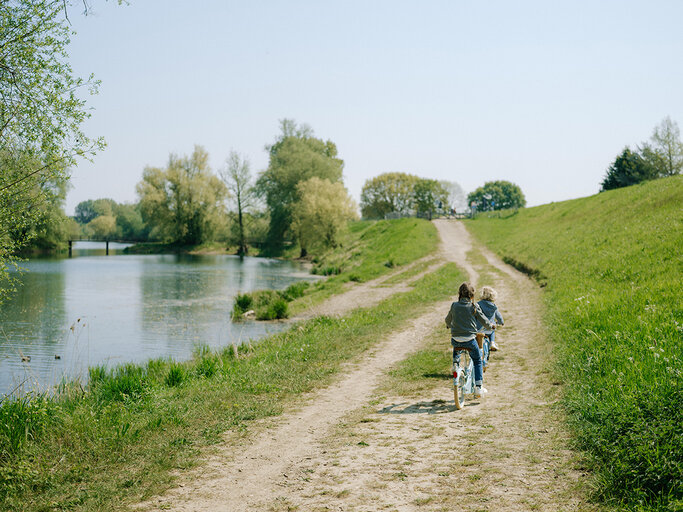The Maas is the boss in the east of Limburg. Over the centuries, the river has scoured its way through the beautiful valley, giving nature free rein in several places. The Maas Valley is one of the driest and sunniest regions of Western Europe. The specific soil of gravel and pebbles produces a lot of beauty, from fragrant herbs to graceful vines. In addition, the Maas region is known for its beautiful, authentic villages and the city on the Maas, Maaseik.
Cycling through picturesque villages on the Maas
Oud-Rekem: at junction 58
Culture enthusiasts will enjoy Oud-Rekem. This beautiful village on the Maas has one of the most authentic village centres in the Maas Valley River Park. Cycle around and you’ll soon understand why. You can pretend like you’re living in the time of knights and damsels as you wander amongst the many historical buildings, cobbled streets, and castles. Be sure to stop at the Groenplaats, where you can visit the museum church and the museum pharmacy.
Leut: between junctions 50 and 56
The Vilain XIIII castle in the centre of the village of Leut is particularly eye-catching. The extensive castle park will make you get off your bike for a walk along stately lanes and past giant trees. Visit the castle’s cellars to taste the wine produced on the estate itself. The Leut village square is also a pleasant place to sit on a bench in the shade of the lime trees.
Stokkem: between junctions 50 and 49
Stokkem is most famous for its basket weaving. At its peak in the second half of the 19th century, an estimated 14,000 to 15,000 baskets were made per week. Today, references to basketry can still be found everywhere. You can visit the small weaving museum in the Maas Centre De Wissen. De Wissen is also the ideal starting point for a walk through the cross-border nature reserve of Negenoord-Kerkeweerd, once a gravel extraction area. Now, you can spot large grazers such as Galloway cattle and Konik horses there. An earthen observation tower is located at the highest point in the middle of the area. That’s the place to be for a wonderful view!

Maaseik: at junction 24
The city of Maaseik is the pearl of the Limburg Maas region. The statue of the Van Eyck brothers on the Markt will immediately catch your eye. Although it is not 100% certain, it is generally assumed that Maaseik is the birthplace of the painters Jan and Hubert van Eyck. It’s pleasant to stroll past the beautiful façades around the market square. The many outdoor cafés invite you to stop for a drink. We definitely recommend stopping by Melk & Suiker when you’re in Bleumerstraat. They sell the one and only Maaseyker knapkoek, a regional product that was already quite popular in the 17th century.
Aldeneik: between junctions 24 and 25
Aldeneik is just a stone’s throw from Maaseik. On the banks of the Maas, the vineyards of the Aldeneyck wine estate reach down to the water. If you plan your bicycle tour on a Friday or Saturday, you can taste this Maasland wine at the outdoor wine bar. Stretch your legs on a short walk around the Heerenlaakplas. After the land was cleared, the area was redesigned into a landscape with park-like features and paved paths.
Kessenich: at junction 21
This is the last village you’ll visit on the Belgian side before the Maas enters the Netherlands. In a distant past, Kessenich was close to the Maas, but the riverbed has moved further and further away over the centuries. Several old channels can still be identified in the vicinity of the village, one of which is the swamped Maas meander that we now know as Vijverbroek. You have a wonderful view of the Drie Eigen – Kessenich and the Dutch villages Neeritter and Thorn – from the spot where the Motte Tower stands.

Cycling through Maasland
Explore the picturesque villages on the Maas and the cultural pearl Maaseik by bike. ‘Waar de Maas baas is’ (Where the Maas is Boss) takes you on a 50-kilometre loop past Stokkem, Maaseik, Aldeneik, and Leut. Cycling along the entire Limburg Grensmaas region is possible via the Meuse Route. This Flemish Iconic Route can be followed using both the well-known junction signs and the more specific Iconic Route signs.

